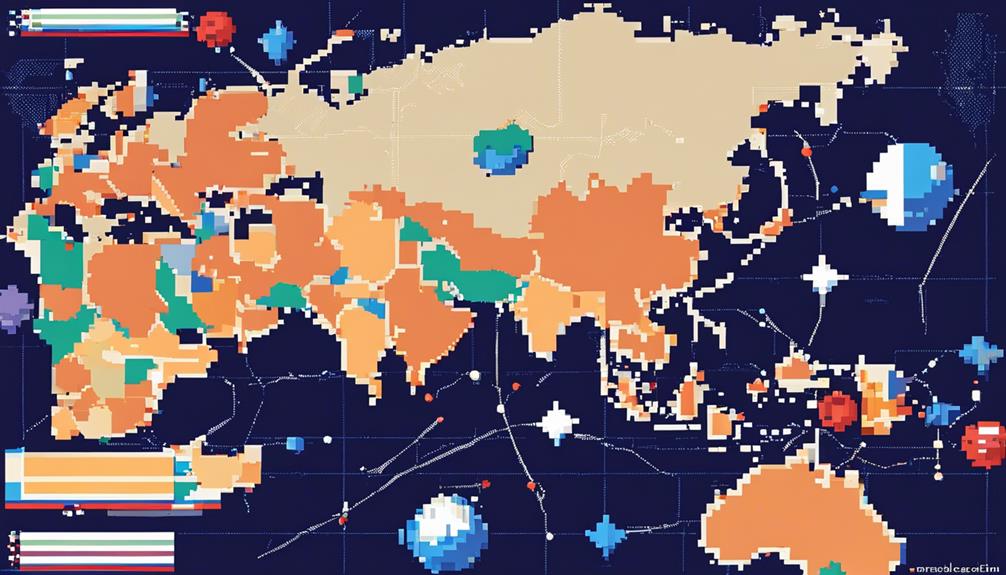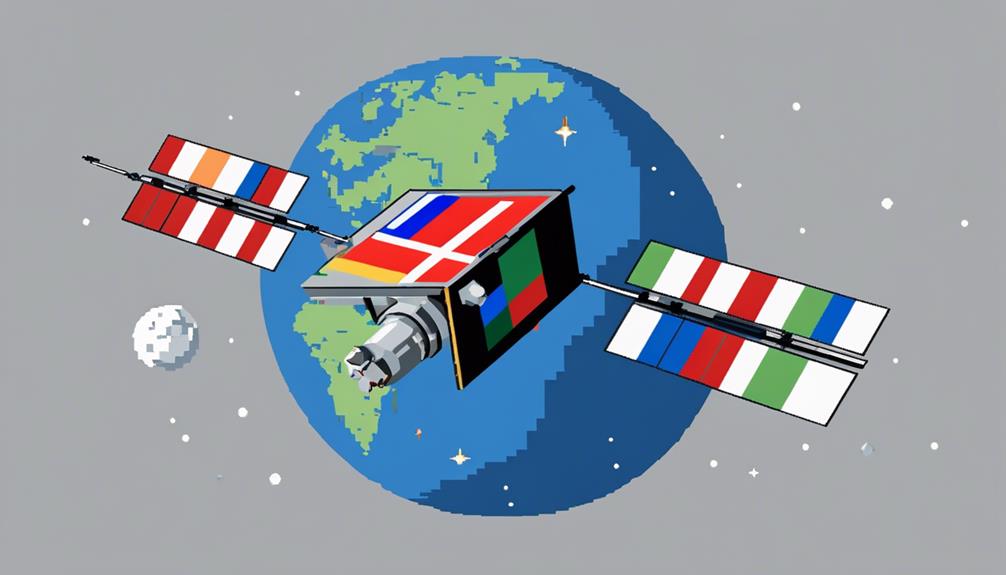In the realm of satellite technology, Russia's Sputnik project emerges as a formidable contender in the global satellite internet race, positioning itself to challenge established players in the industry. With a keen focus on bolstering its satellite capabilities and leveraging cutting-edge technologies, Russia aims to carve out a significant share of the burgeoning satellite-based internet services market. As the competition intensifies and the demand for reliable global connectivity grows, the strategic maneuvers of Russia's Sputnik initiative warrant a closer examination to discern the potential implications it may have on the evolving landscape of satellite internet services.
Key Takeaways
- Russia's Sputnik project aims to establish a global satellite internet network for enhanced connectivity.
- Sputnik satellites offer high-speed internet services worldwide, positioning Russia as a key player.
- The project contributes to expanding global connectivity options and revolutionizes internet coverage.
- Sputnik's impact on global connectivity is significant, influencing modern communication infrastructure.
Russia's Satellite Internet Constellation

Russia's ambitious satellite internet constellation project, named 'Sphere,' is poised to revolutionize global connectivity through the deployment of a sophisticated network comprising hundreds of satellites in various orbital planes. The Sphere project, driven by Russia, aims to bridge the digital divide by offering high-speed internet access to underserved regions worldwide. By strategically placing satellites in multiple orbital planes, the Sphere satellite internet constellation seeks to ensure comprehensive global internet coverage, enabling users in even the most remote areas to access reliable connectivity.
This initiative aligns with Russia's goal to enhance its technological prowess and compete in the global satellite internet market. The Sphere project represents a significant step towards expanding Russia's presence in the space-based internet race, showcasing its commitment to advancing connectivity on a global scale. Through this endeavor, Russia aims to not only provide internet access to those currently lacking it but also to establish itself as a key player in the evolving landscape of satellite internet services.
As Russia's Sphere project progresses, it is expected to play a crucial role in shaping the future of satellite internet technologies, potentially influencing how nations and companies approach the delivery of internet services to populations worldwide.
Global Competition in Satellite Internet
What strategic approaches are global providers employing to gain a competitive edge in the satellite internet market? Competition in the global satellite internet market has intensified as companies like Russia's Sputnik, SpaceX's Starlink, and OneWeb strive to expand connectivity to underserved regions and bridge the digital divide. To gain a competitive edge, these providers are focusing on innovation, high-speed internet delivery, and network expansion. The table below outlines key strategies employed by global satellite internet providers:
| Strategic Approach | Description | Impact |
|---|---|---|
| Innovation | Constantly developing and enhancing satellite technology to improve internet speeds, coverage, and reliability. | Drives technological advancements and enhances user experience. |
| High-speed Internet Delivery | Prioritizing the delivery of high-speed internet to users in rural and remote areas, offering comparable speeds to traditional terrestrial connections. | Addresses the need for fast and reliable internet access in underserved regions. |
| Network Expansion | Expanding satellite networks to reach more users globally, particularly in areas with limited or no access to traditional internet infrastructure. | Increases connectivity options and decreases the digital divide in remote locations. |
Russia's Sputnik Satellite Initiative

Russia's Sputnik satellite initiative represents Russia's endeavor to establish a global satellite internet network, focusing on enhancing connectivity in remote and underserved areas. By harnessing advanced technology, Sputnik satellites offer high-speed internet services worldwide, positioning Russia as a key player in the competitive satellite internet market. The Sputnik project aims to provide reliable internet coverage in regions lacking traditional infrastructure, contributing to the expansion of global connectivity options.
Sputnik Satellite Technology
Utilizing cutting-edge technology, the Sputnik satellite initiative by Russia aims to revolutionize global satellite internet coverage. The Sputnik satellites leverage advanced technology to provide high-speed internet services worldwide, positioning Russia competitively in the global satellite internet race. Specifically designed to improve connectivity in remote areas and cater to underserved regions, these satellites exemplify Russia's commitment to enhancing global internet access. The table below highlights key aspects of Russia's Sputnik satellite technology:
| Aspect | Description | Importance |
|---|---|---|
| Advanced Technology | Utilizes state-of-the-art technology for efficient global satellite internet coverage | Enhances performance |
| High-Speed Internet | Delivers fast internet services worldwide, meeting the demands of modern connectivity | Improves user experience |
| Remote Connectivity | Focuses on connecting remote areas, bridging the digital divide and expanding internet access | Ensures inclusivity |
| Global Competition | Positions Russia as a key player in the competitive market for satellite internet solutions | Strengthens market presence |
Global Internet Coverage
Building upon the advanced technology and global competitive positioning of Russia's Sputnik satellite initiative, the focus now shifts to examining the project's impact on enhancing global internet coverage. The Sputnik constellation, through its satellite initiative, aims to provide high-speed internet access to remote regions and underserved areas worldwide. By leveraging satellite technology, Russia's Sputnik initiative intends to address the digital divide by offering reliable and affordable internet services where traditional infrastructure is lacking. This strategic move places Sputnik in direct competition with other global connectivity providers like SpaceX's Starlink and OneWeb, positioning itself as a key player in expanding internet access and connectivity on a global scale. Through its ambitious goals, Sputnik seeks to revolutionize global internet coverage and contribute towards bridging the gap in digital accessibility.
Satellite Internet Market Strategies
In the competitive landscape of the satellite internet market, strategic planning plays a critical role in determining the success of providers like SpaceX, OneWeb, and Amazon as they aim to deploy global satellite constellations for expanded internet coverage. To excel in this market, companies are implementing various strategies:
- Innovative Satellite Constellations: Providers are designing advanced satellite constellations, such as SpaceX's Starlink, to enhance global internet coverage and provide high-speed connectivity to remote regions.
- Focus on Bridging the Digital Divide: Strategies are tailored to bridge the digital gap by offering affordable and reliable internet services to underserved areas, thus addressing the global digital divide.
- Embracing LEO Satellites: Leveraging Low Earth Orbit (LEO) satellites, companies can achieve lower latency and faster data transmission rates, ensuring improved internet experiences for users worldwide.
- Investment in Satellite Technology: Continuous investment in cutting-edge satellite technology is crucial for enhancing data transmission capabilities, ensuring seamless global connectivity solutions for customers.
These strategic initiatives reflect the dynamic nature of the satellite internet market, where providers are striving to leverage technological advancements to offer widespread, high-speed internet access and address the connectivity challenges faced by populations worldwide.
International Satellite Internet Expansion

The expansion of international satellite internet services involves establishing global connectivity through satellite networks, a strategic endeavor pursued by leading companies like SpaceX, OneWeb, and Amazon. These companies are investing in Low Earth Orbit (LEO) satellite constellations to provide high-speed internet access worldwide. The goal is to bridge the digital divide by offering connectivity to remote and underserved areas, revolutionizing internet accessibility.
In the modern space race for Global Satellite Internet dominance, companies are in a competitive Launch phase, aiming to deploy advanced satellite systems quickly. However, international expansion in this sector faces challenges such as regulatory hurdles and spectrum allocation issues. Regulatory hurdles involve navigating different countries' regulations and licensing requirements for satellite operations, while spectrum allocation is crucial for ensuring that satellite systems do not interfere with each other or existing communication networks.
As companies push forward with their satellite internet initiatives, navigating these obstacles will be critical to success. The competition is fierce, with each player vying for a piece of the global satellite internet market. The strategic positioning of satellites in LEO constellations will play a significant role in determining the effectiveness and reach of these services on a global scale.
Russia's Role in Space Technology
Peering into the realm of space technology, what pivotal role does Russia play in shaping the global landscape of satellite advancements and exploration? Russia's contribution to space technology is profound and enduring, with a rich history that has significantly influenced the course of satellite technology and space exploration. Here are some key aspects highlighting Russia's role in space technology:
- Historic Milestones: Russia made history with the launch of Sputnik 1 in 1957, marking the beginning of the space age. Yuri Gagarin's pioneering journey as the first human in space further solidified Russia's position in space exploration.
- Agency Leadership: The Russian space agency, Roscosmos, stands at the forefront of global satellite technology. Through Roscosmos, Russia has been actively involved in launching satellites for communication, navigation, and scientific research purposes.
- Diverse Expertise: Russia's expertise in space technology extends beyond traditional satellites. The country excels in satellite imaging, space probes, and engages in fruitful international collaborations on various space missions.
- Satellite Internet Advancements: Russia's advancements in satellite internet technology are evident through projects like OneWeb. By developing satellite constellations like OneWeb, Russia aims to enhance global broadband coverage, showcasing its commitment to innovation in the global satellite race.
Russia's influence in space technology remains pivotal, with the country continuing to push boundaries and drive advancements in satellite technology and space exploration.
Sputnik's Impact on Global Connectivity

Evidencing a pivotal shift in global connectivity, Sputnik's launch in 1957 revolutionized satellite technology and laid the groundwork for modern satellite-based internet networks. The successful launch of Sputnik marked the dawn of space exploration and satellite technology, fundamentally influencing global connectivity. By demonstrating the feasibility of satellite communications, Sputnik spurred advancements that led to the establishment of global satellite internet networks. This impact on global connectivity has been profound, as it enabled the provision of satellite internet services to remote regions, bridging the digital divide and enhancing communication networks worldwide.
The legacy of Sputnik in global connectivity is evident in the transformative effects it had on information exchange and data transmission. The development of satellite internet technology following Sputnik's launch facilitated seamless connectivity across vast distances, revolutionizing how people communicate and access information globally. Today, Sputnik's impact continues to resonate in the satellite internet industry, serving as a cornerstone for modern communication infrastructure. By enabling enhanced communication, research capabilities, and access to information on a global scale, Sputnik's influence on global connectivity remains a testament to the power of satellite technology in shaping the modern world.
Challenges in Satellite Internet Industry
The satellite internet industry faces significant challenges that impede its growth and widespread adoption. Overcoming issues such as signal latency, bandwidth limitations, and weather interference requires advancements in satellite technology. These obstacles highlight the necessity for continuous innovation to enhance the reliability and efficiency of satellite internet services.
Industry Growth Obstacles
Numerous challenges confront the satellite internet industry's growth trajectory, ranging from regulatory hurdles and high infrastructure costs to limited coverage in underserved regions and competition from alternative broadband technologies.
- Regulatory hurdles impacting satellite internet growth.
- High initial infrastructure costs hindering industry expansion.
- Limited coverage in rural and remote areas posing a barrier to growth.
- Latency issues affecting real-time applications.
These obstacles, including delays in satellite launches due to regulatory approval processes and the struggle to reach underserved regions without reliable terrestrial connectivity, highlight the complexities faced by satellite internet providers. Moreover, the competition from 5G networks and fiber optic connections adds further pressure on the industry to innovate and adapt to secure its position in the market.
Technology Advancements Needed
Advancements in satellite technology are crucial for addressing the challenges faced by the satellite internet industry, particularly in enhancing data transmission speeds and global coverage. To overcome these obstacles, space technology must focus on satellite constellations, signal processing, and infrastructure investment. Effective constellation management is essential for improving reliability, scalability, and overall performance of satellite-based internet services. Moreover, integrating advanced signal processing techniques can optimize data throughput and minimize latency, enhancing the quality of internet connectivity. Increased investment in satellite communication infrastructure is imperative to meet the rising demands for high-speed internet access worldwide.
| Satellite Technology Advancements | |
|---|---|
| Satellite Constellations | Overcome coverage limitations |
| Signal Processing | Optimize data throughput and minimize latency |
| Infrastructure Investment | Meet growing demands for internet access |
| Constellation Management | Enhance reliability, scalability, and performance |
Future Prospects for Russian Satellite Internet

Future Projections for Russian Satellite Internet point towards a strategic and competitive position in the global connectivity market. Russian satellite internet provider OneWeb is poised to make a significant impact with its innovative approach to delivering high-speed broadband services through a constellation of low Earth orbit satellites. Here are some key aspects shaping the future prospects for Russian satellite internet:
- Global Competition: OneWeb's ambitious plan to launch 648 satellites reflects Russia's intent to compete on a global scale, catering to areas lacking adequate internet infrastructure.
- Strategic Partnerships: The collaboration between OneWeb and Roscosmos underscores a concerted effort to enhance satellite internet capabilities, indicating a strategic alignment to capture a larger market share.
- Technological Advancements: Russia's investment in OneWeb signifies a commitment to leveraging cutting-edge space technology for advancing digital connectivity, showcasing a forward-looking approach in a competitive landscape.
- Market Expansion: By focusing on underserved regions worldwide, OneWeb's initiative not only addresses connectivity gaps but also opens up new market opportunities for Russian satellite internet services, positioning them favorably in the evolving industry.
The future trajectory of Russian satellite internet appears promising, with OneWeb's strategic endeavors and technological advancements poised to carve out a significant presence in the global satellite internet market.
Innovations in Satellite Internet Technology
Satellite internet technology has seen remarkable advancements in recent years, contributing to a transformative shift in global connectivity via satellite networks. Since the launch of Sputnik, innovations in satellite internet technology have revolutionized communication capabilities by enabling higher data speeds, lower latency, and expanded coverage worldwide. Satellite internet providers such as SpaceX's Starlink, OneWeb, and Amazon's Project Kuiper are engaged in a fierce competition to deploy extensive constellations of satellites to facilitate global internet access. The utilization of Low Earth Orbit (LEO) satellite constellations offers distinct advantages over traditional geostationary satellites, including reduced signal travel time, improved bandwidth, and enhanced coverage capabilities.
The competition in the global satellite internet race is propelling significant advancements in satellite technology, ushering in a new era of connectivity for remote and underserved regions globally. These advancements are not merely incremental but rather transformative, with implications for bridging the digital divide and connecting previously isolated communities. By pushing the boundaries of innovation in satellite internet technology, providers are striving to meet the growing demands for high-speed, reliable internet access across the globe. As the industry continues to evolve rapidly, the landscape of global connectivity via satellite networks is poised for further enhancements and breakthroughs in the near future.
Frequently Asked Questions
Who Were the Russians Competing With in the Space Race?
In the sphere of the Cold War's technological battleground, the Russians found themselves in an intense rivalry with the United States in the realm of space exploration. Competing for global superiority, the Soviet Union and the US engaged in a fierce technology race centered around space satellites. This international competition propelled advancements in space technology, marking a significant chapter in the history of mankind's exploration beyond Earth's boundaries.
What Role Did Sputnik Play in the Space Race?
The launch of Sputnik played a pivotal role in the space race by marking the first artificial satellite in orbit, showcasing Soviet technological advancements. This event triggered a surge in global competition, heightened Cold War tensions, and accelerated scientific achievements in space exploration. Sputnik's historical significance lies in its demonstration of global impact, political ramifications, and the race for technological superiority, setting the stage for further international competition in space exploration.
How Did the Soviet Satellite Known as Sputnik Impact the United States Government?
The Soviet satellite Sputnik profoundly impacted the United States government by triggering a heightened sense of urgency during the Cold War. The successful launch sparked a technology race, prompting a significant political response with increased funding for space exploration. This event led to educational reforms, scientific advancements, and a focus on national security measures to address public fear and ensure the country's competitive edge in the global arena of space technology.
What Happened in the Sputnik Crisis?
During the Sputnik Crisis, the launch of Sputnik I by the Soviet Union instilled public fear in the U.S., highlighting technological advancements during the Cold War. This event had significant political implications, accelerating space exploration efforts and scientific achievements. It reshaped international relations and military strategies, prompting the U.S. government to prioritize education and national security. The crisis marked a pivotal moment in history, influencing subsequent developments in space technology and geopolitics.

